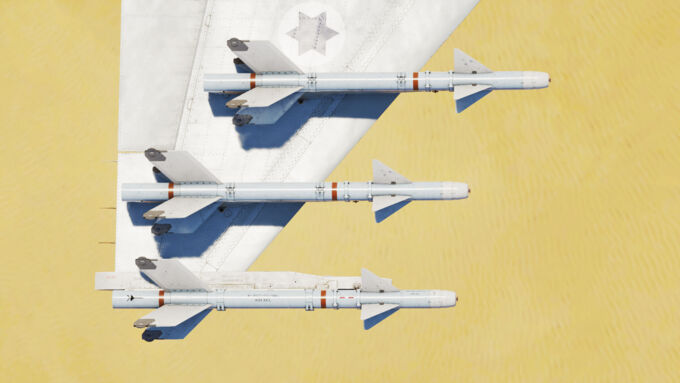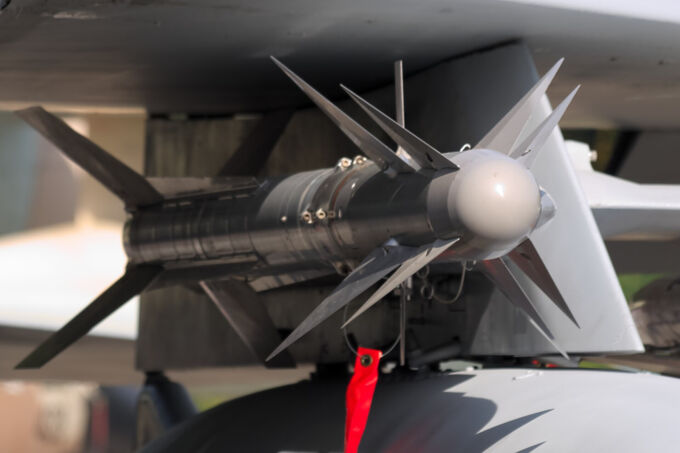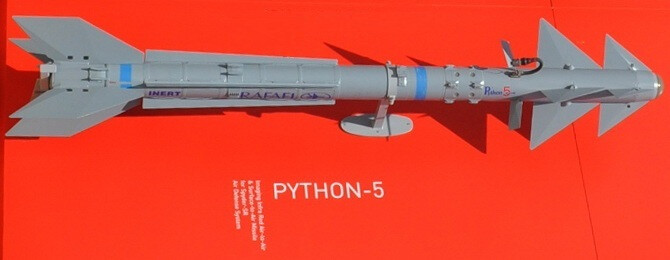A brief history
Israeli air-to-air missiles were the result of the IAF’s (Israeli Air Force) need for a capable domestic air-to-air missile. Various conflicts during the 1950s and 1960s caused supply issues for the IAF, which led to the IAF prioritizing the creation of an indigenous air-to-air missile to reduce dependencies on imported weaponry.
The Shafrir 1 entered operational status as Israel’s first indigenous air-to-air missile in 1963, being produced by Rafael (an Israeli defense company). The Shafrir 1 was innovative but suffered from various reliability issues. To rectify the issues of the Shafrir 1, Rafael developed the Shafrir 2, solving the shortcomings of its predecessor. The Shafrir 2 was used in a variety of conflicts and was eventually exported to other countries.
Newer missiles after the Shafrir 2 adopted the more western name of Python to cater to export markets. The Python 3 is a further refinement of the previous Shafrirs, with the missile being a major leap in technology when compared to the previous Shafrir 2.
The Python 4 was introduced in 1993, being developed off of the Python 3. The main improvements were the addition of new IRCCM technology for better resistance against flares and other false heat targets and greatly improved aerodynamics. Rafael also developed an ARH missile off the Python 4 known as the DERBY, with a different seeker head and enlarged booster to enhance its maximum range.
The Python 5 is the latest missile in the Python family and one of the most advanced air-to-air missiles in the world and entered service with the IAF in 2003. The Python 5 is compatible with various fighter aircraft and has been integrated into air defense systems, such as the SPYDER.
The I-DERBY and I-DERBY-ER are improved versions of the regular DERBY ARH, with new ECCM technology introduced with the I-DERBY and the I-DERBY-ER receiving an enhanced booster to increase its effective range. The SKYSTING (previously known as the Skyspear) was unveiled by Rafael in 2023 and is a long-ranged ARH. Although information about the SKYSTING is limited, it is most likely a greatly improved version of the I-DERBY-ER.
Note: The Shafrir and Python are infrared heatseeking missiles, while the DERBY missiles are radar missiles with the original DERBY being based off of the Python 4.
Table of contents
Shafrir
Python
DERBY
SKYSTING
Shafrir 1
The Shafrir 1 was the result of Israel’s first attempt at producing a domestic air-to-air missile. Designed with a modestly small motor and warhead, the Shafrir 1 suffered from the lack of a proximity fuse for the warhead and its low effective range. Although it did not live up to the IAF’s expectations, it provided a basis for the development of its more famous and advanced successor, the Shafrir 2.
In War Thunder, the Shafrir 1 is simply known as the Shafrir, and functions similarly to the AIM-9B and R-3S. It is mainly useful for intercepting large aircraft like bombers or for destroying players who are unaware or flying slowly. It has a short effective range of 1-2 km and can easily be dodged by maneuvering at high speeds due to the Shafrir’s poor tracking and G-overload.
Vehicles equipped with the Shafrir 1
- Sambad
- Vautour IIA
- Vautour IIA IDF/AF (premium vehicle in the French Aviation Tree)
- Vautour IIN
Shafrir 2
The Shafrir 2 is the successor to the Shafrir 1/Shafrir, with much-improved reliability and maneuverability. The performance of the Shafrir 2 was initially meant to be achieved with the Shafrir 1, but due to technical shortcomings this did not happen. Although the Shafrir 2 was less technologically advanced when compared to its counterparts like the AIM-9D and AIM-9G, it saw much success during the Yom Kippur War in 1973 and is credited with 89 enemy kills.
Changes from the Shafrir 1
- Missile now has an uncaged seeker
- Improved G overload (10 → 18 Gs)
- Improved booster and higher effective range
The Shafrir 2 gives players more advantages over the previous Shafrir when it comes to aerial dogfights. The Shafrir 2 has an uncaged seeker and better maneuverability, giving players using it more tactical freedom when engaging targets. However, the missile is very draggy and loses speed very quick, so the optimal distance is around 1.5 to 2 km.
Python 3
The Python 3 was a further refinement of the Shafrir 2. Introduced into service in 1978, the Python 3 proved its worth in the Lebanon War in 1982, where it destroyed 35 aircraft. With a higher top speed than the Shafrir 2, the Python 3 is a much more lethal and versatile missile than its predecessors.
Did you know? Pre-production models of the Python 3 were used in actual air-to-air combat against Syrian aircraft during the Lebanon War.
Changes from the Shafrir 2
- All-aspect and radar slaving capabilities
- Greatly improved maneuverability (18 → 40 Gs), top speed, and effective range
- Improved reliability
The Python 3 is a significant improvement over the Shafrir 2, with all-aspect capability and extremely good speed, range, and maneuverability when compared to the preceding Shafrirs and other missiles such as the AIM-9L and R-60M. The Python 3 can be a very entertaining and effective missile to use against enemies as it has a tendency to go “nuts” and beeline for enemies while accelerating to Mach 3.5 in mere seconds. Additionally, the Python 3 has excellent range, and is effective until 4 km in most situations thanks to its very high top speed. The main drawback of the Python 3 is its lack of IRCCM and poor resistance to flares.
The Python 3 also was exported to China and produced under license as the PL-8. It is identical to the Python 3.
Python 4
Note: The Python 4 is only available through custom missions and cannot be used in regular battles.
The Python 4 is Israel’s fourth generation AAM, being deployed on Israeli F-15s and F-16s during the early 1990s. Being able to purse targets even after an initial miss, the Python 4 is an extremely advanced missile and is reportedly more advanced than its global counterparts, like the AIM-9M and R-73.
Changes from the Python 3
- New aerodynamically optimized fins and structure, allowing the missile to pull sharp maneuvers without the use of thrust vectoring
- Dual band IRCCM and background infrared rejection technology
- Integrated with Elbit’s DASH HMD allowing the missile to be used in off-boresight scenarios
The Python 4 is available in the WT files, but it cannot be used in regular battles and can only be accessed through custom missions.
Python 5
Note: The Python 5 has not been added to War Thunder yet.
The Python 5 is the IAF’s 5th-Generation and most advanced IR air-to-air missile, with advanced seeker and thrust vectoring technology, making it near-impossible to dodge with evasive maneuvers or countermeasures. It entered service with the IAF in 2003 and is being used by various militaries around the world, such as the Singaporean Air Force (RSAF).
Changes from the Python 4
- Addition of thrust vectoring and LOAL technology to further enhance the missile’s effectiveness
- Greatly improved IRCCM and no-escape zone
Although the Python 5 is supposed to be a short-range air to air missile, its effective range can near typical BVR distances. The Python 5 can also engage targets from any angle and can even target planes that are behind the launching plane due to new LOAL capability. The Python 5 also employs an extremely advanced seeker head, with electro-optical technology. Typical air-to-air missiles “see” aircraft as dots based on their heat signature, making them relatively easy to distract when using false heat targets. The new electro-optical technology “sees” targets as a clear image, making the Python 5 extremely resistant to flares.
DERBY
Known interchangeably as the DERBY or Alto, the DERBY is an Active Radar Homing missile (ARH) largely based off of the Python 4, with changes to the booster, seeker, and fins. The DERBY is Israel’s indigenous ARH missile, supplementing the American AIM-120 AMRAAM in the Israeli Air Force.
Changes from the Python 4
- IR seeker head replaced by an active radar homing seeker
- Larger booster to improve the missile’s effective range
The DERBY is similar to the R-77 and MICA, with a limited effective range in exchange for better close-range maneuverability. Due to this, the DERBY has a rather poor sustainer and high drag, making it less effective at higher distances. Due to this, the DERBY is the most effective at closer ranges.
Unfortunately, the DERBY is the weakest ARH in performance, with the R-77 and MICA having better close range maneuverability, while the AIM-120 and PL-12 have a much higher effective range than it.
Vehicles equipped with the DERBY:
The South African export version of the DERBY known as the R-DARTER is also present on the JAS39C in the British Aviation tech tree. The R-DARTER is near-identical to the DERBY but weighs 2 kilograms more and has slightly worse acceleration and ΔV. However, there is no noticeable difference between the DERBY and R-DARTER when using them.
I-DERBY
Note: The I-DERBY has not been added to War Thunder yet.
The I-DERBY is similar to the regular DERBY, but with more modern technology. It was officially unveiled in 2015.
Changes from the DERBY
- Improved ECCM
- Improved seeker head
I-DERBY-ER
Note: The I-DERBY-ER has not been added to War Thunder yet.
The I-DERBY-ER is the I-DERBY fitted with a more powerful booster. The Indian Air Force has reportedly planned to procure the I-DERBY-ER to arm its Su-30MKI fighter jets.
Changes from the I-DERBY
- Improved booster, increasing the missile’s effective range to around 70 km
SKYSTING
Note: The SKYSTING has not been added to War Thunder yet.
The SKYSTING is Rafael’s 6th-Generation air to air missile, unveiled at the 2023 Paris Air Show. The SKYSTING can be used on both old and new aircraft and has improved ECCM and EW to improve its reliability.
Changes from the I-DERBY-ER
- Different fin arrangement visually
- Not much is known about the SKYSTING yet
Credits
Images are from their respective sources if mentioned. Otherwise, all other images are by me. The missile diagram was made in Figma.















